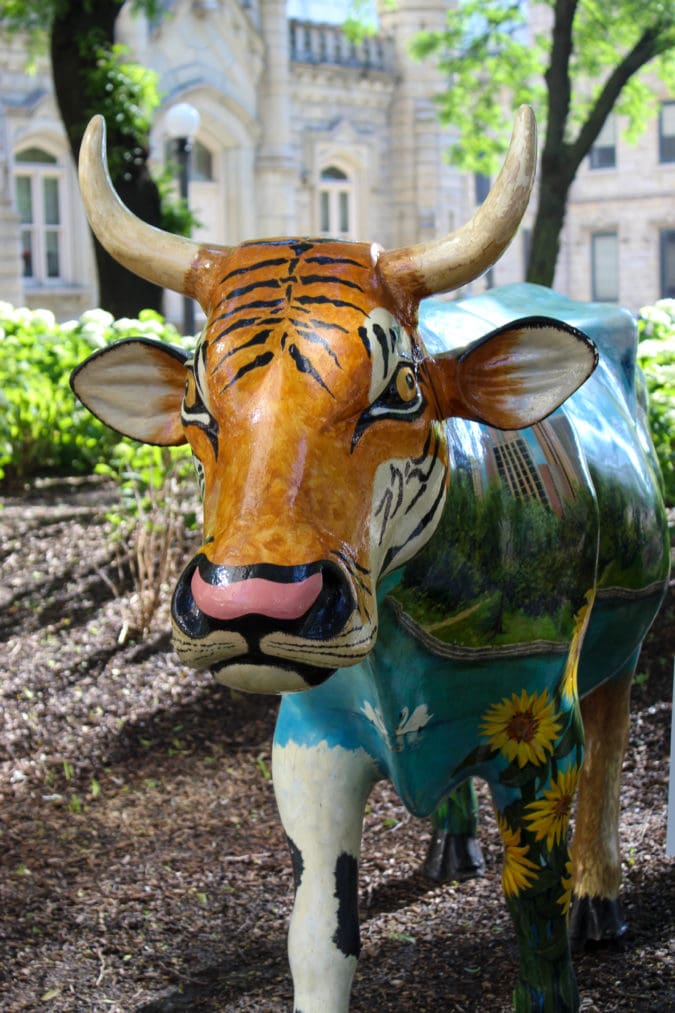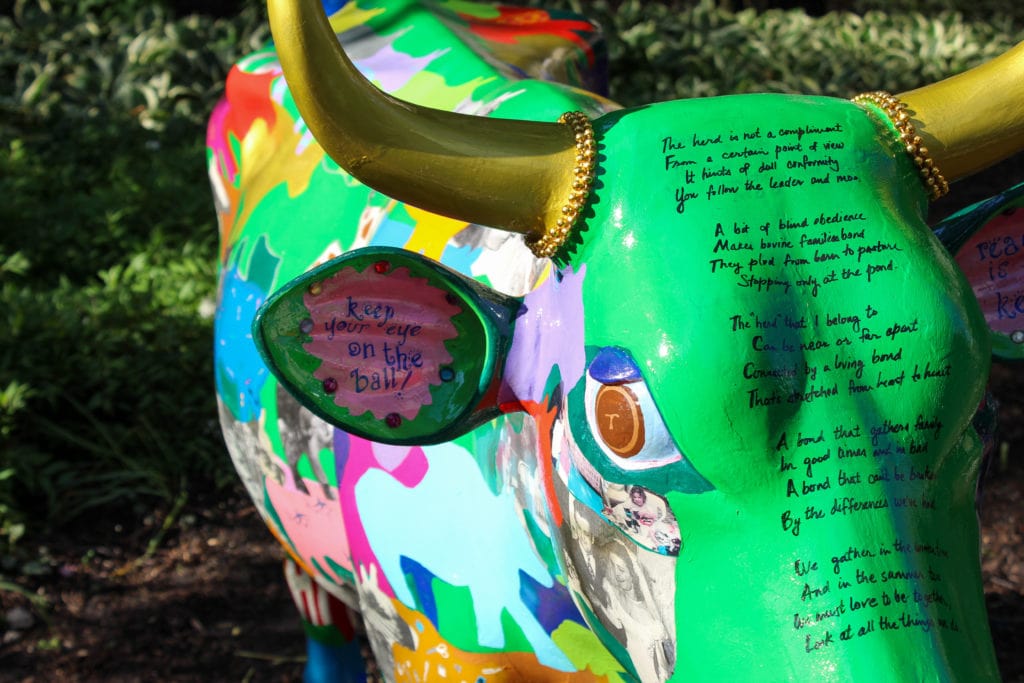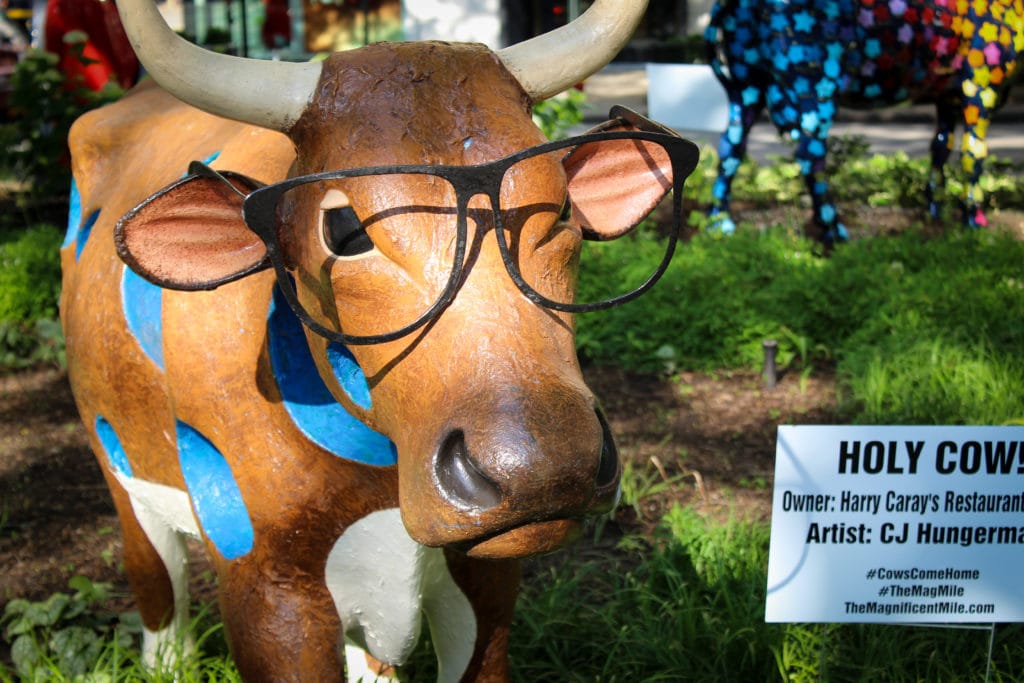If you’ve ever visited the downtown of a major U.S. city, there’s a good chance you’ve seen one. You’ll spot them on street corners, in parks, even on the roofs of buildings. Some are sitting down, but most are standing upright in a walking position. All have horns, some also have hats. And despite looking relatively the same, each one is incredibly unique.
I’m talking about the famous cows from “Cows on Parade”—a 1999 Chicago-based art installation that featured over 300 life-size fiberglass cows. And this July, in an effort to honor the 20th anniversary of the trend-setting exhibition, the city of Chicago is calling the cows home.

How now, brown cow?
In the summer of 1999—after being inspired by “CowParade,” a collection of fiberglass cows in Switzerland—Chicago businessman Peter Hanig, along with Commissioner of Cultural Affairs Lois Weisberg, decided to organize an event where local Chicago artists could decorate cow statues and place them in various spots throughout the city.
Hanig’s mission was simple: Spark joy and give back to the community. Local businesses paid $3,500 to sponsor a cow, $1,000 of which would go to an artist selected from a city-compiled pool. Once the artist was chosen and the work was completed, the cow randomly appeared in a public place, posing for just a few months before being auctioned off and all of its proceeds donated to charity.
“We have never estimated anything so poorly in our lives, and we have never been so pleased to be so wrong.”
And while the mission may have been simple, the impact was anything but. By midsummer, more than 330 cows had been loosed on Chicago sidewalks, their designs celebrating everything from the “L” train to Marilyn Monroe to literary elocution (one particularly brown cow outside of Columbia College had “HOW” painted on one side and “NOW” on the other). Word about these colorful mooers quickly spread, and more than 2 million people flocked to see the statues before they were taken down and auctioned off. And when auction day did arrive in late October, the cows—which were only expected to raise a maximum of $328,000—garnered nearly $3.5 million.


Helyn Goldenberg, who was chairman of Sotheby’s Midwest at the time, told the Chicago Tribune: “We have never estimated anything so poorly in our lives, and we have never been so pleased to be so wrong.”
Cows come home
Since 1999, “Cows on Parade” has spread to 79 cities around the world. It is estimated that over 5,000 cows have been created and more than $30 million has been raised for various global charities. And thanks to the mandated auctions, these flamboyant cows have found homes all over the map, turning up in places like the oldest privately owned residence in New York City and the middle of a glass window in Buenos Aires. In fact, the most expensive cow was Wage Moo, a mosaic-style cow covered in thousands of Waterfold Crystals that sold for $146,000 at an auction in Dublin in 2003.

Unfortunately, Wage Moo won’t be in Chicago for the 20th anniversary event, but there will be plenty of other cows to spark some serious sidewalk joy. Being referred to as the “Cows Come Home” exhibit, 14 different cows (well, technically 14-and-a-half) will be scattered throughout Jane Byrne Park for a month-long display—and it seems more cows get added every day.
When I stopped by to check out “Cows Come Home,” I was utterly (or should I say udderly) blown away by each statue’s level of detail. Everything from the texture of the trees painted on one, to the tiny gold beads adorning the horns of another, the artistry is truly incredible. Each cow comes with its own sign, providing the statue name, the owner, and the original artist. When you’re there, be sure to check out both the water lily-clad cow named Moonet and Hanig’s very own red cow named End of Parade (hint: he’s the reason there are 14-and-a-half).
The anniversary installation is being called “Cows Come Home.” | Photo: Amanda Bungartz The artistry on many of the cows is insanely detailed. | Photo: Amanda Bungartz This beautiful cow, called Herd Instinct, depicts pictures of the artist’s family. | Photo: Amanda Bungartz All of the cows in Jane Byrne Park are located behind small fences. | Photo: Amanda Bungartz The new installation is located right behind the Historic Water Tower along Michigan Avenue. | Photo: Amanda Bungartz Moonet features water lilies and blue swirls, much like a classic Monet painting. | Photo: Amanda Bungartz Holy Cow! is one of the more famous statues that has returned to Chicago for the anniversary tour. | Photo: Amanda Bungartz
And if you’re wondering “why cows?”—you’re not alone. CowParade Holdings Corporation, the official owner of the CowParade brand, posted this statement on its website: “The cow represents different things to different people around the world but the common feeling is one of affection. There is something magical about the cow that transcends throughout the world. She simply makes everyone smile.”
If you go
“Cows Come Home” is on display until July 31 in Jane Byrne Park, right behind the Historic Water Tower. The park is open all day, seven days a week. The Historic Water Tower building is open from 10 a.m. to 7 p.m. Monday through Friday, and 10 a.m. to 5 p.m. on Saturday and Sunday.














